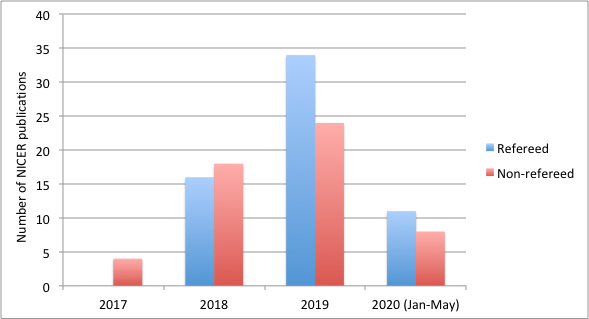NICER / ISS Science Nugget
for June 4, 2020
NICER celebrates 3 years in space
This week, NICER celebrates its third anniversary on orbit. Launch on 3 June 2017 aboard SpaceX CRS-11 was
followed by installation and activation on ELC-2 a few days later. A one-month checkout period demonstrated
nominal performance of all systems, and science observations began on 17 July 2017. Since that time, NICER has:
- Observed 577 distinct targets, including black holes, flaring stars, active galaxies, and its key-science
neutron stars – three of NICER's neutron-star papers were among the top 5 downloaded from The Astrophysical
Journal Letters in 2019 despite having been published with less than three weeks remaining in that year.
- Accumulated 87 million seconds of commanded exposure, of which 57 Msec resulted in high-quality science
data (exceeding pre-launch expectations for observing efficiency).
- Served 57 unique Principal Investigators of peer-reviewed science proposals, dozens of
target-of-opportunity requests, and countless other scientists who freely download data from the NICER archive at
GSFC's High-Energy Astrophysics Science Archive Research Center (HEASARC).
- Contributed to three successful PhD theses.
The NICER team and the broader X-ray astrophysics community are grateful for the ISS Program's science and
operations support!

Figure:
The NICER mission has so far generated 127 published papers – 64 in peer-reviewed journals and the rest primarily
as time-sensitive Astronomer's Telegrams. A dozen pre-launch (June 2017) publications described the mission and
set the stage for anticipated science returns; the remaining 115 papers and brief communications disseminated
science results that have been cited more than 1,000 times.
<< Previous
Main Index
Next >>